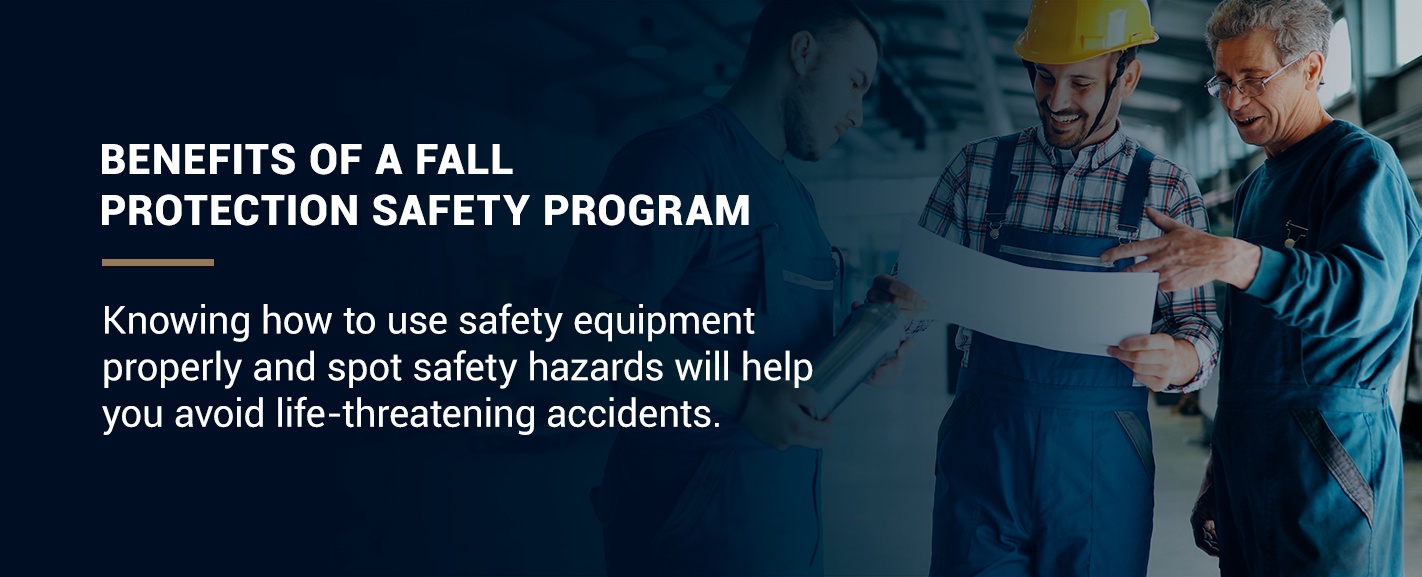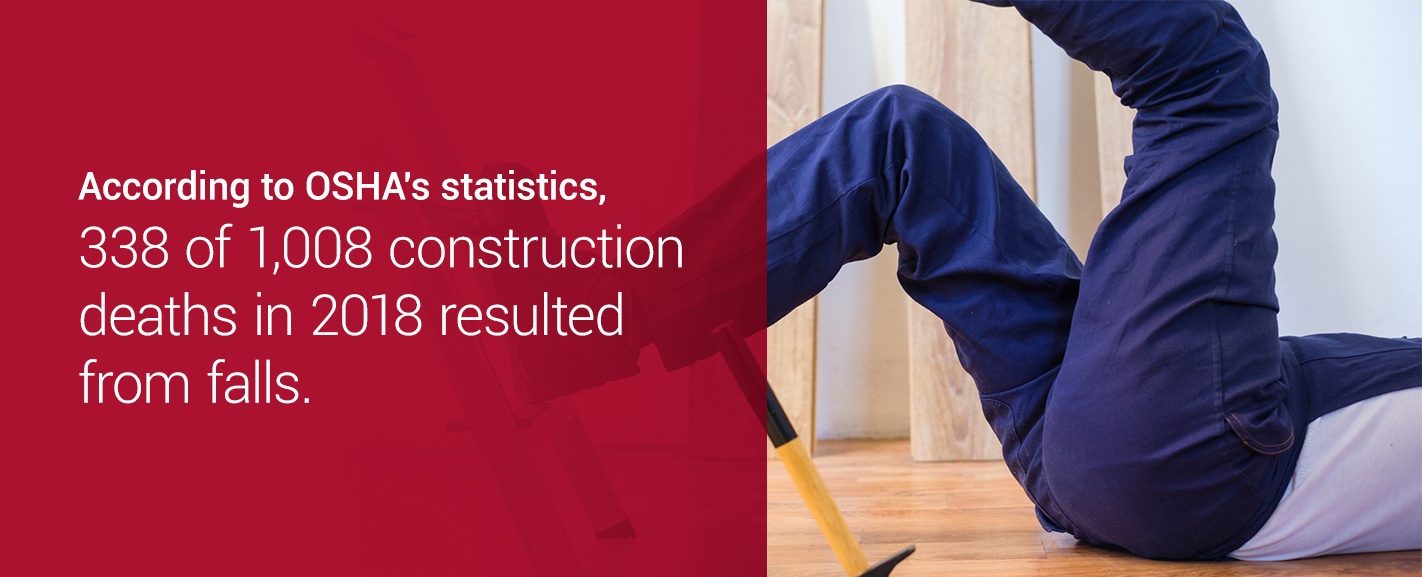Fall Protection Safety Course

Jump To:
- What Is Fall Protection Safety?
- Why Is Fall Protection Safety Important?
- Topics Covered in Our Safety Training Course
- Industries That Require a Fall Protection Safety Course
- Who Should Take Fall Protection Training?
- Benefits of a Fall Protection Safety Program
- Fall Protection Safety Course Online
Falls are one of the leading causes of death and injury to construction workers every year. Job sites can be dangerous places. When you work from heights, your chances of sustaining bodily harm increase. That’s why you need to invest the time and resources into taking a fall protection safety course.
Fall protection safety is key to a healthy and productive work environment. Knowing the protocol for working from heights can be the difference between life and death. When it comes to the safety of yourself and your fellow workers, trial and error is not an option. Take a fall protection safety course to prepare for the dangerous task of working from heights.
View NASP’s Fall Protection Certificate Course
What Is Fall Protection Safety?
According to the Occupational Safety and Health Administration’s (OSHA) guidelines, fall protection safety measures must exist on job sites dealing with heights. OSHA demands that you equip and operate such job sites with additional precautions to ensure worker safety. Here are some common types of protection used on these worksites:
- Guardrails.
- Stair railings and handrails.
- Safety net systems.
- Personal fall arrest systems, such as safety harnesses and lines.
- Inspections of fall protection equipment.
Each of these protections helps keep workers safer on job sites with heights. In addition to these measures, OSHA outlines the mandatory responsibilities of employers in these environments. Some of them include:
- Provide working conditions free of known and obvious dangers.
- Keep work area floors clean, and if possible, dry.
- Select and provide personal protective equipment, including fall protection gear, for workers at no cost to them.
- Train workers about job hazards using language they can understand.
Employers and employees must come together to achieve fall protection safety on the job. Employers have several responsibilities required by law to keep you safe. But, as a worker, you must also stay up to date on the latest safety measures, precautions and practices so you can maintain your safety daily.
Why Is Fall Protection Safety Important?
According to OSHA’s statistics, 338 of 1,008 construction deaths in 2018 resulted from falls. A falling incident on the job site can happen at a moment’s notice. That’s why it’s important to take the necessary safety measures beforehand. Here are some of the most common causes of falls on construction sites:
- Slippery, unstable or disorganized walking areas.
- Holes in floors.
- Unprotected edges.
- Openings in walls.
- Dangerous or improper use and positioning of ladders.
- Misused fall protection equipment.
It can be too easy to neglect safety measures. With proper training, you can be aware of these dangers and make changes to counteract them. This will keep yourself and everyone else safer.
Topics Covered in Our Safety Training Course
Fall protection competent person training can equip you to be a safety leader on your job site. The National Association of Safety Professionals (NASP) offers a fall protection safety course that will give you the basic training you need to work safely from heights. Here are some fall protection safety course topics covered in our program:
- An overview of fall protection.
- Fall protection equipment, tools and resources.
- Ways to identify and reduce hazards.
- Techniques for selecting, maintaining and inspecting equipment.
Through this training, you will familiarize yourself with the ins and outs of fall protection. Understand your job site’s fall protection plan. Use the information you’ll learn in this course to discover and fix areas of the worksite that present a falling risk.
Purchase Our Fall Protection Safety Training
Industries That Require a Fall Protection Safety Course
Construction work often deals with heights. Therefore, employees should take fall protection safety courses. In addition, many other industries require their workers to carry out tasks from heights. Working from heights is more common than you might think, and there are always added risks for workers when performing such tasks. OSHA has different protocols for various industries that involve tasks like working from heights. OSHA puts their fall protection safety regulations into two general categories:
- Construction, outlined in Regulation 1926, Subpart M.
- General Industry, outlined in Regulation 1910, Subpart D.
Within these categories are many jobs and professions you may not commonly associate with heights. However, they deal with heights regularly and require OSHA regulations to keep workers safe. Besides construction, shipyards and longshoring industries require fall protection safety measures. General industries also need safety measures for heights over 4 feet. This can be for any task that workers must carry out from that height or higher. Additionally, any industry that involves working over dangerous machinery and equipment requires safety protocols.
Who Should Take Fall Protection Training?
If you are a construction worker who participates in tasks covered by OSHA’s regulations for fall protection, then you should take a fall protection training course. Workers, supervisors and managers alike who perform their tasks from or near heights need to understand the fundamentals of working safely. If you work with any of the following elements of construction, you should sign up for a training course:
- Leading-edge work.
- Hoist areas.
- Formwork.
- Rebar.
- Walkways.
- Excavations.
- Roofing activities.
- Wall openings.
These parts of construction work can be dangerous if approached in an uninformed or careless way. Everyone on the job site involved with these aspects of the construction process must take a training course to become a competent person with fall protection.
Benefits of a Fall Protection Safety Program

Fall protection safety programs make the construction process better for everyone, from business owners to manual laborers. Working from heights is dangerous, and having a fall protection safety program keeps everyone safer. As a construction worker working from heights, it is your right to understand the measures your employer takes to keep you safe. Knowing how to use safety equipment properly and spot safety hazards will help you avoid life-threatening accidents.
Business owners and clients also benefit from fall protection safety programs. Workers will complete tasks quickly and efficiently, facilitating happy clients. Most importantly, you will complete tasks safely. This saves employers money in the form of injury leave, medical expenses and legal fees. Plus, if OSHA finds a job site is not up to spec, they can impose fines and even shut the area down until it meets fall protection requirements. Establishing a fall protection safety program beforehand can help avoid these repercussions.
Purchase NASP’s Fall Protection Safety Course Online
Don’t wait until an accident happens to start thinking about fall protection safety. Today is the day to start fall protection training to become a qualified person on the job site. Work from heights safely by investing in the right training course.
NASP offers real-world training built by safety professionals, for safety professionals. Contact us today if you have any questions about our offerings, or purchase our online fall protection safety course if you’re ready to get started. Fall protection safety doesn’t have to be difficult or confusing. Sign up for our course and learn how NASP provides The Practical Approach to Workplace Safety.
Blog Posts
Latest Posts
Related Posts





